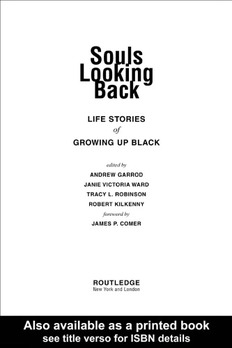
Souls Looking Back: Life Stories of Growing Up Black PDF
Preview Souls Looking Back: Life Stories of Growing Up Black
Souls Looking Back Souls Looking Back LIFE STORIES of GROWING UP BLACK edited by ANDREW GARROD JANIE VICTORIA WARD TRACY L. ROBINSON ROBERT KILKENNY foreword by JAMES P. COMER ROUTLEDGE New York and London In recognition of their perseverance, insight, and honesty, this book is dedicated to the 16 student autobiographers whose essays are presented here. Published in 1999 by Routledge 29 West 35th Street New York, NY10001 Published in Great Britain by Routledge 11 New Fetter Lane London EC4P4EE This edition published in the Taylor & Francis e-Library, 2002. Copyright ©1999 by Routledge All rights reserved. No part of this book may be reprinted or reproduced or utilized in any form or by any electronic, mechanical, or other means, now known or hereafter invented, including photocopying and recording, or in any information storage or retrieval system, without permission in writing from the publishers. Library of Congress Cataloging-in-Publication Data Souls looking back: life stories of growing up Black / Andrew Garrod...[et al.], eds. p. cm. Includes bibliographical references.(p. ) and index. ISBN 0-415-92061-2 (hc.). (Print Edition)— ISBN 0-415-92062-0 (pbk.) 1. Afro-American youth—Race Identity—Case Studies. 2. Afro-American youth—Biography 3. Afro-American youth—Social conditions—Case studies 4. Racially mixed children—Race identity—Case studies. 5. Racially mixed children—Biography 6. Racially mixed children—Social conditions—Case studies. 7. United States—Race relations—Case studies. 8. Canada—Race relations—Case studies. 9. West Indies—Race relations—Case studies. I. Garrod, Andrew, 1937– E185.625.S675 1999 305.235—dc21 98-42839 CIP ISBN 0-203-90375-7 Master e-book ISBN SBN 0-203-90379-X (Glassbook Format) Contents Forward James P. Comer IX Preface XIII Introduction XVII I. Social Class and Race Class and Race in Negotiating Identity Peter C. Murrell Jr 3 1 (cid:1) Born with a Veil Prince 15 2 (cid:1) What Is Black Enough? Maria 32 3 (cid:1) Living between the Lines Alessandro 47 4 (cid:1) I Reconcile the Irreconcilable Rob 60 II. Identity The Social Constructions of Race, Ethnicity, and Culture Jewelle Taylor Gibbs 75 The Intersections of Identity Tracy L. Robinson 85 5 (cid:1) Color-blind Christine 99 6 (cid:1) Walking a Thin Line Liz 112 7 (cid:1) Becoming Myself Claudio 121 8 (cid:1) Becoming Comfortable in My Skin Susanna 134 9 (cid:1) Caught between Two Cultures Steve 148 10 (cid:1) Lost in the Middle Scott 159 III. Resilience and Resistance Resilience and Resistance Janie Victoria Ward 173 11 (cid:1) Gotta Keep Climin’All de Time Chantal 186 12 (cid:1) Finding Zion Viola 203 13 (cid:1) Feeling the Pressure to Succeed Rick 218 14 (cid:1) Running Hurdles Stacey 231 15 (cid:2) Reflections on My Survival Malik 245 16 (cid:2) Quest for Peace Denise 261 References 281 About the Contributors, Editors, and Foreword Writer 289 Index 291 Foreword JAMES P. COMER R ace is probably the most challenging issue facing our nation as we move into the new millennium. Yet many Americans donít want to talk about it. The report of President Clinton’s Commission on Race barely made a ripple. The highly acclaimed film Amistad played to small audiences. Too many parents don’t dis- cuss race with their children, leaving them vulnerable to negative and limiting experiences in the society. And many Blacks and Whites born after the very vis- ible period of Civil Rights activities in the 1950s and ’60s ask, “What’s the problem?” Most people want to move on to the bright new America without undoing the ill effects of the past. The reason is understandable, but it can’t be done. In a nation caught in a historical contradictionóslavery and oppression despite a commitment to freedom and opportunityódenial is deep and well pro- tected. Fear of confronting the “big lie” of white superiority, and losing the short term benefits of racial scapegoating underlines the nation’s inability to lis- ten and talk about race. Getting past the myths and blinders that protect denial is a significant challenge. For this reason almost all of my work over the past 30 years flows from an initial discussion of my own life experiences. My personal story allows the reader to see, hear, and, most importantly, feel as I do to a greater extent than does the “cold” analysis of the social scientist. And because of the process of identification with the author, it provokes less guilt and obstructive defensiveness. While there has been much progress in American race relations, similar and new problems remain. An article in a recent issue of the Indiana University Col- lege of Arts and Sciences magazine, “ASense of Belonging, ASpirit of Hope” by Lisa Sorg, described the racial challenges confronting today’s Black stu- dents. The author compared some of my experiences at the university almost 50 years ago drawn from my book Maggie’s American Dream, with those of today’s students. I was struck by the similarities and the difference: only slightly increased Black student and faculty numbers, isolation, strained Black- White interactions in and outside of classrooms, subtle and occasional overt racist acts that challenge the sense of belonging, and I am sure, impair the per- formance of too many Black students. The difference is that such an article would not have appeared 50 years ago. And university officials are aware, con- cerned, and trying to create better conditions. Souls Looking Back presents the emotionally honest reflection of sixteen
